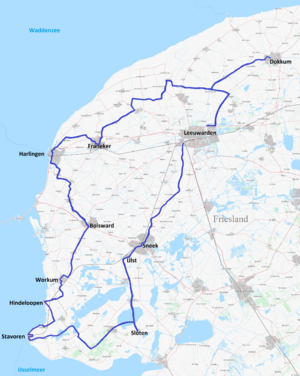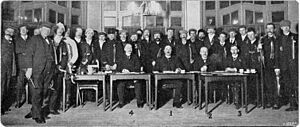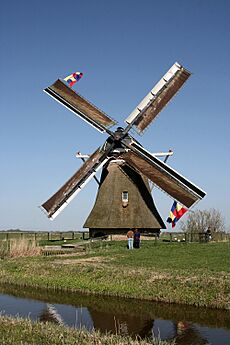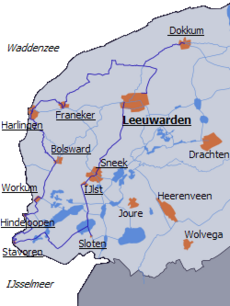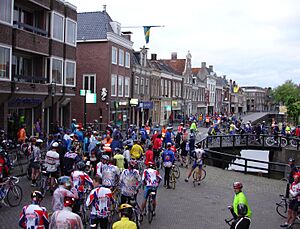Elfstedentocht facts for kids
Statue in Leeuwarden of an Elfstedentocht competitor. The eleven cities and all the winners are listed on the plinth
|
|
| Sport | Tour skating and speed skating |
|---|---|
| Founded | 1909 |
| Countries | World |
The Elfstedentocht (which means "Eleven Cities Tour" in English) is a super long ice skating event in the Netherlands. Skaters glide almost 200 kilometers (about 125 miles) on natural ice. It's both a serious race for about 300 top skaters and a fun tour for 16,000 other skaters. This makes the Elfstedentocht the biggest ice-skating tour in the world!
This amazing tour happens in the province of Friesland, in the northern part of the Netherlands. Skaters visit all eleven historic cities of Friesland. The tour can only happen when the natural ice along the whole route is at least 15 centimeters (6 inches) thick. Sometimes it happens in a few years in a row. Other times, there can be gaps of more than 20 years between tours. When the ice is finally thick enough, the tour is announced. Then, it starts within just 48 hours!
Sadly, the Elfstedentocht is now in danger because of climate change. In the last 50 years, it has only happened three times. The most recent tour was in 1997.
Contents
The Ice Skating Route and Rules
The Elfstedentocht is a circular route. It follows frozen canals, rivers, and lakes. Skaters visit eleven historic cities in Friesland. These cities are Leeuwarden, Sneek, IJlst, Sloten, Stavoren, Hindeloopen, Workum, Bolsward, Harlingen, Franeker, and Dokkum. The tour then finishes back in Leeuwarden.
The ice must be at least 15 centimeters (6 inches) thick. This is very important because about 15,000 amateur skaters take part. The last tours were held in 1985, 1986, and 1997. All skaters must be members of the Association of the Eleven Frisian Towns. They also need a special starting permit and a bib. Skaters must collect a stamp in each city. They also need stamps at three secret checkpoints. Everyone must finish the course before midnight.
Sometimes, the ice is too thin in certain spots. These places are called "kluning points." Skaters have to walk on their skates over a carpet to the next good ice. In 1997, they even moved ice from other places to make weak spots stronger. This helped under bridges, for example.
The finish line of the Elfstedentocht is on a canal near Leeuwarden. It's called the "Bonkevaart." It's close to a famous windmill, De Bullemolen, in Lekkum.
Cities on the Route
Here are the cities on the Elfstedentocht route and how far they are from the start:
| City | Frisian Name | Distance from Start (km) |
|---|---|---|
| Leeuwarden (start) | Ljouwert | 0 |
| Sneek | Snits | 22 |
| IJlst | Drylts | 26 |
| Sloten | Sleat | 40 |
| Stavoren | Starum | 66 |
| Hindeloopen | Hylpen | 77 |
| Workum | Warkum | 86 |
| Bolsward | Boalsert | 99 |
| Harlingen | Harns | 116 |
| Franeker | Frjentsjer | 129 |
| Dokkum | Dokkum | 174 |
| Leeuwarden (finish) | Ljouwert | 199 |
The Excitement of the Elfstedentocht
Because the Elfstedentocht happens so rarely, everyone gets super excited when it's announced. When it seemed like a race might happen in 2012, the Dutch Prime Minister, Mark Rutte, even joked about it. He said that for a few days, the country isn't run by the government. Instead, it's run by the people in Friesland!
As soon as temperatures drop below freezing, the news starts talking about the chances of a tour. The longer it stays cold, the more intense this "Elfstedenkoorts" (eleven cities fever) becomes. It turns into a huge national excitement when the tour is actually announced. The night before the tour, many Dutch people go to Leeuwarden. They enjoy a giant street party called the "Nacht van Leeuwarden" (Night of Leeuwarden).
On the day of the tour, many Dutch people either stay home to watch it on TV. Millions of people tune in! Others find a spot along the route to cheer on the skaters. They might even take the day off from school or work. In February 2012, hotels in Friesland were completely booked. People expected millions of visitors, even before the tour was officially announced.
History of the Elfstedentocht
People have talked about skaters visiting all eleven cities in Friesland in one day since 1760. The Elfstedentocht was already a part of Frisian tradition. Then, in 1890, Pim Mulier had the idea to organize it. The first official tour was held in 1909. Only 22 men competed in that first race. After this race, the Association of the Eleven Frisian Towns was created. This group now organizes all the tours.
In the 1912 tour, Jikke Gaastra was the first woman to finish the Elfstedentocht. However, she couldn't complete the full tour because the ice was not good enough after Sneek. In the 1917 tour, Janna van der Weg was the first woman to finish the entire route.
The winters of 1939/40, 1940/41, and 1941/42 were very cold. The race was held in each of those years. The 1940 race happened just before the German invasion of the Netherlands. Over 3,000 skaters started at 5:00 AM on January 30. The first five finished by 4:34 PM. This event was a huge deal and was on the front pages of Dutch newspapers.
The Elfstedentocht of 1963 is known as "The hell of '63." Only 69 out of 10,000 skaters finished the race. This was because of extremely cold temperatures, lots of snow, and a strong wind. The conditions were so bad that the winner, Reinier Paping, became a national hero. The tour itself became a legend. Paping couldn't even see the finish line because he was snow blind. Many skaters had frostbite, broken bones, and eye problems.
The next Elfstedentocht after 1963 was in 1985. Things had changed a lot by then. Before, skaters would wear newspapers under their clothes to stay warm! In the 20 years between 1963 and 1985, clothing, training, and skates became much better. This changed how people skated.
The 1985 tour was stopped early because the ice started to melt. Skaters were taken off the ice by 10:00 PM. In 1986, the current King, Willem-Alexander, completed the Elfstedentocht. He used the name W.A. van Buren, which is a traditional secret name for the Royal Family. In 1997, Piet Kleine, who had won an Olympic gold medal for speed skating, was disqualified. He missed getting a stamp at Hindeloopen, even though video showed he was there.
The 2012 Elfstedentocht That Didn't Happen
In late January and early February 2012, there was a ten-day cold spell. Temperatures dropped to -22.9°C (-9.2°F) in some places. This made everyone hope for a 2012 Elfstedentocht. Many thought it would happen on Saturday, February 11.
On February 2, 2012, it was reported that 95% of the water locks in the canals were adjusted. This was done to help the ice get as thick as possible. The Dutch weather experts said temperatures would stay below freezing for days. They predicted the ice would be 15 cm (6 inches) thick by February 7. By February 5, they even thought it could reach 25 cm (10 inches)!
On February 6, the organizing committee met for the first time in fifteen years. They were hopeful because the cold weather was continuing. However, some areas still had ice that was too thin. Stavoren was a big problem, with ice only 2 cm (1 inch) thick in some spots.
Later, on February 8, the chairman of the committee announced that the race was off. They had to be realistic. Safety issues made the race impossible. A ten-day cold spell was just not enough for the event. The 1997 event had happened after a 12-day cold spell.
Elfstedentocht Winners
Here are the winners of the Elfstedentocht races. The time shows how long it took the winner to finish. Even if it was warm on the day of the tour, all tours happened after many days of freezing temperatures.
| Date | Temperature | Winner | Time | Distance | Average speed |
Years since previous tour |
|---|---|---|---|---|---|---|
| 2 January 1909 | n/a | Minne Hoekstra | 13:50 | 189 km | 13.7 km/h | — |
| 7 February 1912 | +3.8 °C | Coen de Koning | 11:40 | 189 km | 16.2 km/h | 3 |
| 27 January 1917 | -1.8 °C | Coen de Koning | 9:53 | 189 km | 19.1 km/h | 5 |
| 12 February 1929 | -10.1 °C | Karst Leemburg | 11:09 | 191 km | 17.1 km/h | 12 |
| 16 December 1933 | -2.0 °C | Abe de Vries and Sipke Castelein |
9:05 | 195 km | 19.7 km/h | 5 |
| 30 January 1940 | -6.1 °C | Piet Keijzer, Auke Adema, Cor Jongert, Durk van der Duim and Sjouke Westra |
11:34 | 198.5 km | 17.3 km/h | 6 |
| 7 February 1941 | 0.0 °C | Auke Adema | 9:19 | 198.5 km | 21.3 km/h | 1 |
| 22 January 1942 | -11.7 °C | Sietze de Groot | 8:44 | 198 km | 22.7 km/h | 1 |
| 8 February 1947 | -8.5 °C | Jan W. van der Hoorn | 10:51 | 191 km | 17.6 km/h | 5 |
| 3 February 1954 | -5.4 °C | Jeen van den Berg | 7:35 | 198.5 km | 26.2 km/h | 7 |
| 14 February 1956 | -4.9 °C | no winner declared | — | 190.5 km | — | 2 |
| 18 January 1963 | -7.7 °C | Reinier Paping | 10:59 | 196.5 km | 17.9 km/h | 7 |
| 21 February 1985 | +0.3 °C | Evert van Benthem | 6:47 | 196.8 km | 29.0 km/h | 22 |
| 26 February 1986 | -6.9 °C | Evert van Benthem | 6:55 | 199.3 km | 28.8 km/h | 1 |
| 4 January 1997 | -3.6 °C | Henk Angenent | 6:49 | 199.6 km | 29.3 km/h | 11 |
| Present | — | — | — | — | — | 28 |
Women were first allowed to officially compete in the tour in 1985. Before that, they skated with the amateur group and didn't get an award. The women who crossed the finish line first were:
- 1940 – Sjoerdtsje Faber
- 1941 – Wopkje Kooistra
- 1942 – Antje Schaap
- 1985 – Lenie van der Hoorn
- 1986 – Tineke Dijkshoorn
- 1997 – Klasina Seinstra (7:49.11)
Other Eleven Cities Events
Alternative Elfstedentocht
Since 1989, an "alternative Elfstedentocht" has been held every January. It takes place on the Weissensee lake in Austria. This lake is 12 km (7 miles) long. About 3,000 speed skaters take part in courses of 50, 100, or 200 km (30, 60, or 125 miles). This is probably the world's largest ice sport event.
The Dutch Speed Skating Championship is part of this event. The fastest skaters complete the 200-kilometer course in just over five hours.
Eleven Cities Cycling Tour
The eleven towns cycle race started in 1912. It grew alongside the skating race. But unlike the skating race, the cycling tour happens almost every year. It was only canceled in 2001 and 2020. It takes place on Whit Monday every year since 1947. This event has become very popular. For safety, it's no longer a race. It's now a tour with a maximum average speed.
The cycling tour starts and ends in Bolsward, not Leeuwarden. It's limited to 15,000 people. Entrants leave Bolsward in groups every eight minutes. Those who finish the 235 km (146 mile) course before midnight get medals. In 2013, organizers banned velomobiles from the event. They wanted only two-wheeled bikes powered by people.
Eleven Cities Swim Tour
In 2018, Dutch long-distance swimmer Maarten van der Weijden tried to swim the entire eleven city tour. He had to stop because of bad swimming conditions and getting sick. The next summer, in 2019, he successfully completed the route. He arrived at the finish in Leeuwarden on June 24. His amazing effort raised over €6.1 million for cancer research.
Eleven Cities Triathlon
The Eleven Cities Triathlon was completed for the first time by Frisian triathlete Stefan van der Pal in 2020. In one week, he swam 200 kilometers (125 miles). Then, he cycled the route (7 hours). After that, he ran the route again (32.5 hours). He raised €96,000 for a group that researches brain stem cancer in children.
Between June 18 and 25, 2023, Maarten van der Weijden also completed the Eleven Cities Triathlon. He raised over 3 million euros for cancer research. Unlike van der Pal, who ran, van der Weijden walked the last part.
See also
 In Spanish: Elfstedentocht para niños
In Spanish: Elfstedentocht para niños


